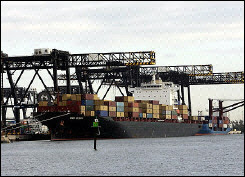Oil prices climbed above 90 dollars on Wednesday as the market awaited the latest weekly snapshot of US energy inventories and after crude had jumped sharply the previous day.
 New York's main contract, light sweet crude for January delivery, added 67 cents to 90.69 dollars per barrel.
New York's main contract, light sweet crude for January delivery, added 67 cents to 90.69 dollars per barrel.Brent North Sea crude for January delivery gained 77 cents to 90.76 dollars. Oil prices rose by around two dollars Tuesday, closing above 90 dollars in New York as traders viewed a quarter-point rate cut by the US Federal Reserve as stimulating the US economy and boosting energy demand.
"The old push for 100 dollars seems to have been replaced by the new push for 90 dollars, suggesting that a bear (weakening) market has taken over," Citigroup analyst Tim Evans said.
Traders were gearing up for US government data on the health of American energy inventories, to be released later Wednesday.
The consensus forecast is for crude oil stockpiles to have fallen by 750,000 barrels during the week to December 7, with distillates dropping 500,000 barrels.
Distillates, which include heating fuel, are being closely watched amid the northern hemisphere winter when demand increases in the United States and Europe.
Even a larger-than-expected drop in distillate stocks may fail to provide support to oil prices, however.
"I think people don't want to buy over 90 (dollars)," said Tetsu Emori, a fund manager with Astmax asset managers in Tokyo.
After a run-up to record highs of close to 100 dollars in late November, oil prices have fallen back on concerns that an economic slowdown in the United States, the world's biggest consumer of energy, could dampen demand.
"The major divide is between those concerned with tight supply as core winter heating demand approaches and worries over slumping energy demand growth as a consequence of a contracting global economy," said MF Global analyst John Kilduff.
Oil prices had won some support Tuesday after a twin car bomb attack rocked Algiers, killing scores of people. Algeria is a member of the Organization of the Petroleum Exporting Countries and although the blasts did not affect oil supplies, they increased the risk premium.
China widen US trade gap
 The US trade deficit widened 1.2 percent in October to 57.8 billion dollars, driven by record high oil prices and an all-time high trade gap with China, the government said Wednesday.
The US trade deficit widened 1.2 percent in October to 57.8 billion dollars, driven by record high oil prices and an all-time high trade gap with China, the government said Wednesday.The October trade deficit was slightly higher than analysts' consensus forecast of 57 billion dollars.
The Commerce Department revised the September gap upward to 57.1 billion dollars from the 56.5 billion dollars initially estimated.
Imports increased 1.0 percent to 199.5 billion dollars and exports 0.9 percent to 141.7 billion dollars, both record levels, the department said.
The October trade balance highlighted two key factors pressuring the US economy: rising oil prices and dependence on Chinese imports. Surging oil prices were the main cause of the widening gap. Prices climbed to a record 72.49 dollars an imported barrel, pushing the oil trade deficit to an all-time high of 26.3 billion dollars. The deficit in other goods, meanwhile, fell to 38.5 billion dollars, its lowest level since March 2004. The trade gap with China soared 9.1 percent to 25.9 billion dollars, representing one third of the total deficit. Imports from China hit an unprecedented 31.6 billion dollars.